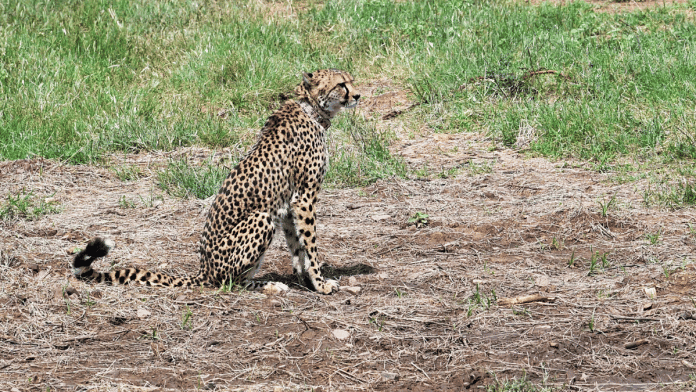New Delhi: Five more cheetahs will be released in the wild in Madhya Pradesh’s Kuno National Park (KNP) before the onset of monsoon while the rest are likely to be set free either in Kuno or in “other areas” after the rains subside in September, the government said Monday.
Three females and two males will be set free from their enclosures, joining three others who are already out in KNP. “These individuals were chosen based on their behavioral characteristics and approachability by the monitoring teams,” the Ministry of Environment, Forests and Climate Change said in a statement.
At the moment, 15 cheetahs, including the five to be released soon, are spending time in larger fenced enclosures as they acclimatise to their surroundings. Ten cheetahs will stay in their enclosures till September, when the monsoons subside, after which “the situation will be reassessed,” and “further releases into KNP or surrounding areas” like Gandhisagar “will be done in a planned manner.”
The cheetahs from South Africa, which were airlifted to India in February, were kept in quarantine there since June 2022.
This release plan departs from the timeline set by the Cheetah Action Plan, which says “male (coalitions) would be released from the holding enclosure first after an appropriate period (1-2 months),” with females following 1-4 weeks after the males.
“We are doing this for two reasons, mainly. One is that the animals have to be staggered when they are released – we are not releasing all of them at once. And second, monitoring them during the monsoon is extremely difficult. Our protocol requires at least one sighting in 24 hours, which is tough in the monsoon season, given Kuno’s landscape,” an official with the National Tiger Conservation Authority (NTCA).
“All of the animals are healthy, and there is enough space inside to allow interactions by opening up the enclosure. We are only doing this so we do not miss monitoring them during the monsoon season,” the NTCA official added.
Since the translocation process began in September 2022, two cheetahs have died — Sasha, in March, due to kidney failure, and Uday in April because of suspected heart failure. The exact cause of Uday’s death is still being investigated, the Ministry said in
its statement.
A team comprising veterinarian Adrian Tordiffe from University of Pretoria, Vincent van dan Merwe of The Metapopulation Initiative, South Africa, Qamar Qureshi, Lead Scientist at Wildlife Institute of India, and Amit Mallick, Inspector General of Forests, NTCA have submitted a report to the government and the status of Project Cheetah based on their visit to KNP on 30 April.
Also Read: Cheetah is India’s new conservation icon after tiger. It can save grasslands
Death of Uday
On 23 April, Uday was found stumbling around and unable to lift his head. The cheetah died after he was rushed to a quarantine enclosure for treatment.
“The initial examination revealed that he had most likely died of terminal cardio-pulmonary failure. Failure of the heart and lungs is common in the terminal stages of many conditions and does not provide much information about the underlying cause of the problem,” the Ministry said in its statement.
The rest of organ tissues appeared to be relatively normal except for a localised area of potential haemorrhage in the brain, it said, adding that there were no other signs of injury or infection.
ThePrint had reported that a team of 5 veterinarians were rushed to conduct the post mortem on Uday.
“His relatively normal blood results and normal white blood cell count indicate that he was not suffering from any infectious disease that could pose a risk to any of the other animals. The histopathology and toxicology reports still need to be finalised before any conclusions can be drawn,” the Ministry said.
The other cheetahs appear to be “perfectly healthy” and are hunting for themselves, it added.
Carrying capacity of Kuno
The cheetah translocation project – the biggest conservation experiment of its kind – has been criticised by wildlife conservationists for the costs and risks involved in the process.
A point of controversy has been the “carrying capacity” of Kuno National Park, which is housing the first tranche of cheetahs. According to the Cheetah Action Plan, Kuno can host “up to 21 cheetahs based on its existing prey base,” and 36 if “the potential cheetah habitat covering over 3200 km²” is properly restored.
Last month, conservationists based in Germany wrote a letter, published in the journal ‘Conservation Science and Practice,’ arguing that the project was planned without considering the cheetah’s “spacial ecology.” It predicted that male cheetahs will venture further than anticipated due to a lack of space, and potentially cause conflict with farmers over livestock.
One of the cheetahs, Pawan, was darted and brought back to Kuno after he ventured out beyond the park and was found close to Uttar Pradesh border, according to a report by The Time of India.
In its statement, the Ministry said cheetahs “will not necessarily be recaptured unless they venture into areas where they are in significant danger,” and the forest department will only intervene if cheetahs drift so far as to lose connection with one another.
“While many have made predictions about the anticipated carrying capacity of cheetahs in KNP based on other ecosystems in Namibia and East Africa, the actual number of animals that the reserve can accommodate can only be assessed after the animals are released and have established home ranges. Cheetah home-range sizes and population densities vary tremendously for different cheetah populations in Africa and for obvious reasons, we do not have useful spatial ecology data for cheetahs in India yet,” the ministry said.
(Edited by Tony Rai)






